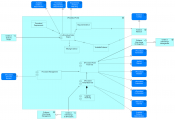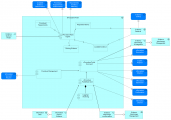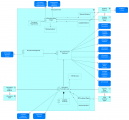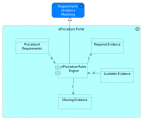EProcedure Portal
The eProcedure portal application collaboration aggregates multiple co-operating application components. It resides at the DC and bundles important functionality for handling a user requesting a public service. The eProcedure portal application offers a UI for interacting with the user and back-end functionality to support the handling of the eProcedure. The user can initiate the eProcedure and later also chose to terminate it if he/she wishes. Through this portal the user makes the explicit request for OOP transfer and receives confirmation when all requirements of the eProcedure are met, i.e. all evidences have been received by the DC. Subsequently the user can choose to submit the eProcedure. The eProcedure portal might offer functionality for save and resume. This to avoid that the user must start all over in case of exceptions (e.g. a piece of evidence not available or when it takes longer than expected). The portal supports the DC in requirements/evidence matching and the determination of already available evidence so that it is clear what is still to be requested to DP(s).
For VC the portal front-end component provides the User with several features, such as initiate or terminate the procedure, accept request for VC from the DC, scan QR code, view evidence status, submit and confirm eProcedure and similar. To enable this level of procedure flow control to the User, there must be a collaboration with the Procedure Management subcomponents. On the other side, the eProcedure back-end component communicates with the Authority Agent through an interface regarding establishing the DID connection through the QR code and it captures all necessary events in the system log files.
The back-end also communicates with the Information Desk to retrieve information about available DPs for issuing the missing VC to the User. The Rules engine component is responsible for evaluating the current evidence status for the User; namely, retrieving the information about evidence that the User currently has available (through evidence matching) and identifying missing evidence according to procedure requirements obtained from querying the eProcedure.
- Graphic representations of the eProcedure Portal application collaboration
| Application Component | Description | Pattern(s) |
|---|---|---|
| eProcedure Portal Front-end | Application component managing the entire interaction between the user and the eProcedure Portal, including e.g. UI framework, specific forms integration with the eProcedure Portal Backend. In case of VC also handles the establishment of DID connections between DP and users. | IM, USI, VC |
| eProcedure Portal Back-end | Application component consisting of all functionality needed to implement the back-end of an eProcedure Portal. | IM, USI, VC |
| Procedure Management | Application component managing the procedure, possibly spanning multiple sessions, for the user. Completing a request for a public service might take longer than one session, e.g. waiting for evidence to be exchanged between DP and DC. Furthermore, exception flows must be considered as errors may occur in the flow. Saving the (public) service request to continue at a later point in time is therefore important functionality making the user’s life easier. The component takes care of persisting the session so it can be resumed at a later point in time avoiding that the user has to start all over again but instead can take it from he/she left off. | IM, USI, VC |
| eProcedure Rules Engine | Application component taking care of matching procedural requirements with evidence and establishing available and missing evidence. | IM, USI, VC, LKP |
| Logging/Archiving | Application component managing logging and archiving of data. Also, to support the audit trail. | IM, USI, VC |



